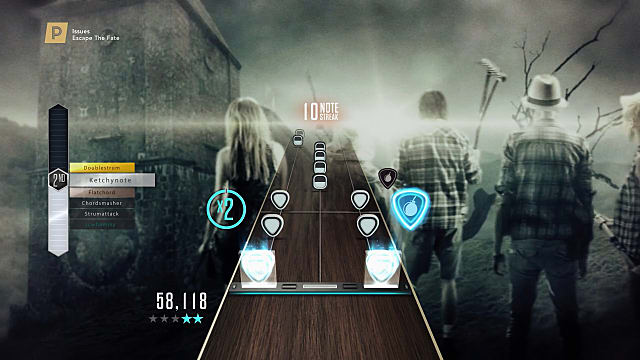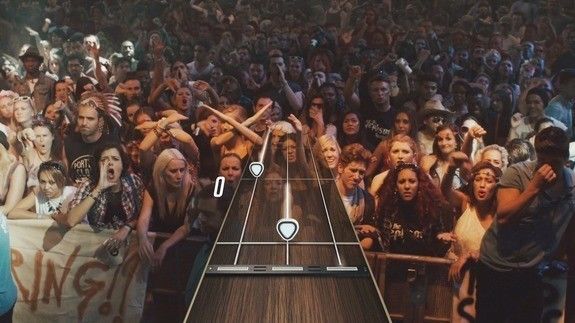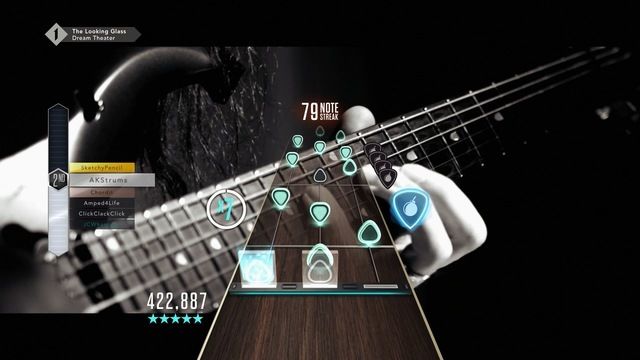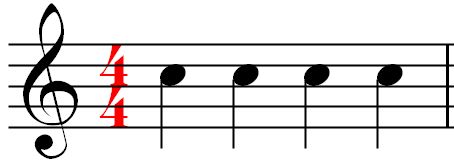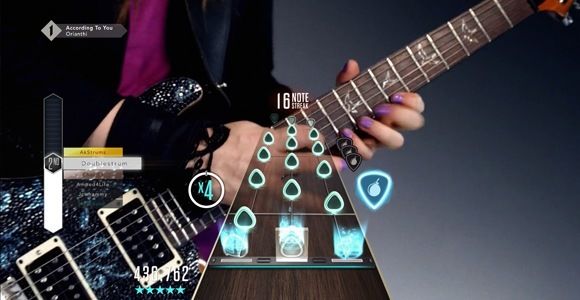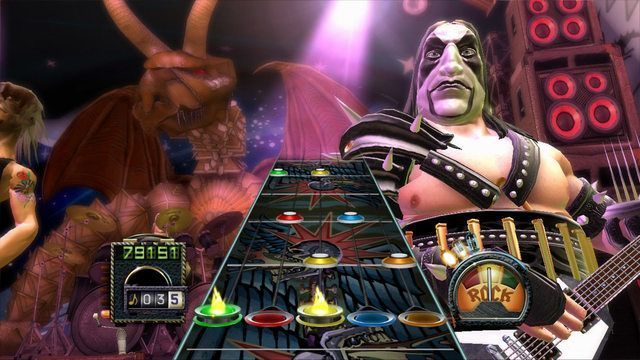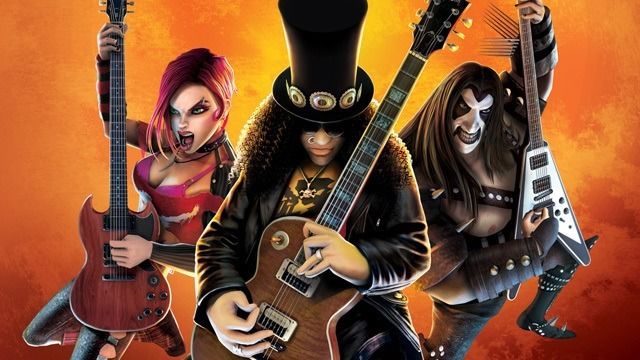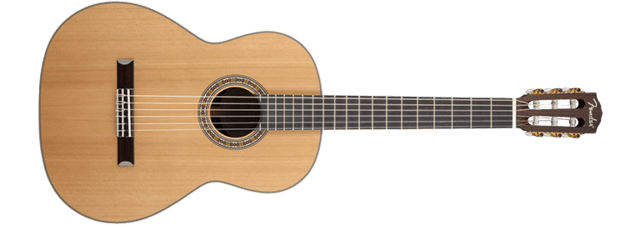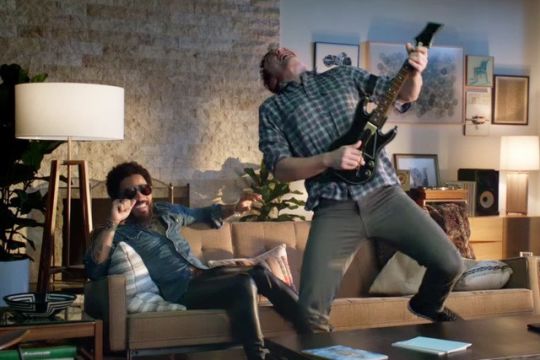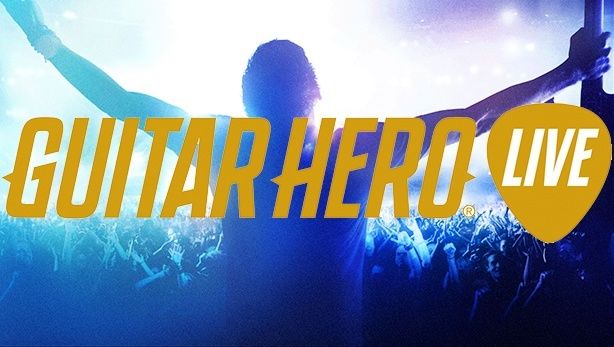The reality is: Guitar Hero is not easy. It looks easy when you see veteran players shred that plastic ’til it melts. It can be extremely misleading to see someone like this play. What are their secrets? How do they do what they do? Fortunately for you, dear reader, I happen to be one of these people. Though I can solo with the best of them, I’m not perfect, and I don’t expect you to be perfect either. What I do expect you to do is read this kick-ass article on every single trick I know to get better at Guitar Hero and to get out there and play that plastic until ya get blistas on ya fingas!
If you’re already a seasoned veteran of Guitar Hero and you’re just looking to improve your Guitar Hero Live game, read along! There will be some valuable tips in here about both classic and new Guitar Hero games.
Still not sure if you think Guitar Hero Live is worth it? Check out our Guitar Hero Live full game and controller review.
This article is LONG and could be tedious or repetitive at times. Structured for Guitar Hero beginners and semi-experienced players alike, you may want to jump to a specific section instead of reading it 100%. For this reason, you can find a list of topics below. Every section will have a heading of the same title as you’ll find in the list. I strongly, strongly suggest you take a look at even the more ridiculous tips as they may provide hidden information that you won’t find elsewhere.
Table of Contents:
Practice Makes Perfect Musical Theory Coordination Learn the Music Starting Off Small Master Special Guitar Hero Tricks Previously Played Play REAL Guitar Enjoy Yourself!
Practice Makes Perfect
Okay, you knew this was coming. Nothing, absolutely nothing, in this entire guide is as important as this. Nothing can save you if you’re not willing to try. Sit down and play. Did you fail? Play it again. Still not doing so well? Suck it up and play it again. This is the number one way to get better at anything. Math homework, talking to girls, talking to boys, Karate, Guitar Hero - you name it, and it gets easier the more you do it. So just try.
Wait until you’re alone if you’re embarrassed. Choose to sing if your friends come over and want to play. If you’re bad at guitar you’re naturally gifted at singing - it’s the way the world is made.
Okay, I lied; maybe screeching like a cat being run over by a bus won’t help your street cred, but that’ll be water under the bridge when you whip out Lamb of God’s “Ghost Walking” and shred like a demon from hell next time your mates are over.
Practice in the basement when everyone is asleep or better yet: practice with a friend who is even worse at the game than you!
Guitar Hero isn’t a game; it’s a lifestyle.
If you can’t make the time to practice and you’re just looking for a quick fix, find a different game to master because that simply will not happen.
“Why are you reading this right now? Shouldn’t you be practicing?!”
Haha, just kidding. You should’ve seen the look on your face! More on getting better at Guitar Hero below!
Musical Theory
Go ahead and study that cheat sheet, the test is next week. In all honesty, knowing a little bit about music will drastically help you in Guitar Hero. I’m not saying, “go change all of your school courses and become a major in musical philosophy.” No, no, don’t do that! Bad idea. But a little side lesson never hurt anyone.
Luckily enough, the small amount of musical theory you’ll need to know to get better at Guitar Hero is pretty basic - you probably know it already! The trick is getting your mind to think about it while playing.
Most of the world has had a music class at some point in their life. We all used to sing songs or play the (shivers run down my spine) recorder. Believe it or not, that’s all you need to know! You don’t need to have played a real guitar in the past (though we’ll talk about that later).
Timing
A basic knowledge of time signatures is all you’ll need to keep a beat and know when to hit the notes that pop up on screen. If you pay close attention to the approaching fretboard, you’ll see small, horizontal, usually white (depending on the fret board) lines that cross from one side to the other. These bars signify… well… bars! (Check out the image above for an example of these bars.)
In sheet music, a beat is picked and set to a time signature (4/4 as seen above, 3/4, 2/2, 6/8, etc.). The two numbers tell the musician how many beats are in each measure, or bar, of music. The bar above is in 4/4 time. Four quarter note beats in a bar, or One, Two, Three, Four, and then you start over in the next bar.
Understanding which time signature a piece is in can help you to land strums on certain notes. Tricky sections might include different types of notes à la half notes, eighth notes, whole notes, etc.
A couple methods for learning the timing of a song would be to practice it (imagine that!), and to listen to it apart from the game (which we’ll touch on in a bit).
You’ve probably had experience dealing with time signatures in the past. You just need to harness those memories and bring them forth while playing.
Keeping the Beat
Once you figure out those tricky time signatures, you’ll probably want to keep the beat while playing your songs! Ever see musicians play live? They often tap their foot to keep track of where they are in the song to keep their pacing. Figure out how fast the white bars are coming towards you and tap your foot every time each of them crosses the strum bar. This way your brain’s conscious functions can focus on the notes while it’s subconscious functions keep the timing of the tune.
Coordination
Guitar Hero cannot be played without some degree of hand-eye coordination. If you’re unfamiliar with the term, coordination is when two processes work hand-in-hand, such as your hand and your eye. Your eye sees things and sends that information to your brain. Quickly your brain must subconsciously send the required information to your hand to move in accordance. Tricky stuff. Good thing the average person is born with a decent amount of it.
To play Guitar Hero, you’ll need a fair amount of hand-eye coordination with both of your hands. Whether you’re a lefty or a righty, you use both while playing - one for strumming and one for fret-work.
The easiest way to increase your hand-eye coordination is - surprise, surprise - practice. An eventual hand-eye connection is bound to form. You shouldn’t have too much difficulty increasing this skill as you use it on a daily basis. Driving, combing your hair, eating your cereal - it all requires coordination. Try eating, or completing similar tasks, with your left hand instead of your right to develop an equal amount of skill.
A quick trick to increasing coordination is to throw an object (preferably a small ball) into the air and catch it without looking at your hand.
Learn the Music
I hope this doesn’t come as a surprise, but: Guitar Hero is a music game. Life changing, I know. In order to do well in a music game it usually helps if you’re a musical person! Make sure you know the tracks that you’ll be playing and you’re almost guaranteed to do better at them.
The greatest part about Guitar Hero Live (in this instance) is that the entirety of GHTV is made up of actual music videos. There is no reason you shouldn’t be able to find an example of each song on YouTube.
Though Guitar Hero Live has more genres of music than we’ve seen in previous games, most of the music is fairly “mainstream” meaning you’ll probably know most of the songs. I didn’t include White Zombie’s “Thunder Kiss ‘65” above for Rob Zombie’s epic dance moves alone. It seems like a strange tune at first but is fairly recognizable once it begins.
Do your research, find out which songs you’ll be playing and listen to them religiously. Make sure you dip out of your comfort zone; a lot of songs you’ll be playing won’t be 100% familiar to you. Who knows, you might end up finding a new favorite genre through this process!
Starting Off Small
This section will be split into two major parts: Starting on Lower Difficulties and Starting on Easier Songs/Genres.
Starting on Lower Difficulties
This one kind of goes without saying. You’re obviously going to start on lower difficulties if you’ve never played the game. However, this section should be helpful for players who have some experience with the game but can’t get to the next level.
Guitar Hero Live features 5 difficulty settings, an upgrade on the 4 previous settings: Easy, Medium, Hard, Expert. We now have Basic, Casual, Regular, Advanced, and Expert.
As for advice regarding your choice of difficulty, Guitar Hero Live’s “career mode” Live features in-game difficulty switching. I suggest starting on a difficulty just above what you are comfortable with. Once you are good enough to play most basic songs, crank up the difficulty by one more notch. There is little difference between the first couple settings. A few more notes, a couple chords, no big deal. Challenging yourself just a little bit is the best way to get better.
Don’t sweat the solos. As you’ll learn below, solos are the trickiest parts of songs, generally come into Guitar Hero games in harder genres like metal and rock, and often appear later in the setlist rotation. If you can’t play a solo on Expert difficulty, don’t worry about it! You can’t fail in Guitar Hero Live. Just turn down the difficulty for that part and play it until it’s mastered. Once you’re ready, turn it back up again.
You’ll find only small difficulty changes between Basic and Regular, though Advanced and especially Expert get to be challenging. Stay on a level just above what you’re comfortable with and you’ll see consistent improvement.
A great tactic for improving your difficulty setting of choice is a friendly competition. Find a friend of roughly the same experience as you and battle them on an extremely difficult song by passing the guitar controller back and forth. Try to get the best score or most % of notes hit. You have no idea what trying to kick your friend’s butt will do for your skills. You’ll be soloing like a pro in no time!
Starting on Easier Songs/Genres
As mentioned above, Guitar Hero Live features a more robust number of genres than even before. That being said, you should know which genres to attack first.
There are certain genres that are best left for a more experienced you, but if you want to jump with both feet you can start with metal. Without a doubt, metal is the hardest genre to play in almost any rhythm game. Every game includes metal, and for good reason. Though it provides the most challenge with difficult rhythms, varied open and fretted strumming, and crazy off-the-rails solos, it is the go-to genre for a fun time. Those of you who have just started, however, should go for something a little more tame…
Some decent choices for first timers include:
Pop Country Techno Rap Soft Punk Indie
Each of these genres are easy to play because of straightforward time signatures, slow tempos, simple chords, or repetitive tracks. Don’t get fooled! Even though most of the songs from these genres are easy, there is the occasional tricky one. In Guitar Hero Live, beginners will find even the easy songs tricky as they will include weird chords that utilize both the top and bottom row of buttons as well as other tricks. Be on your guard.
Genres you should probably stay away from while you’re in the learning cycle would be:
Metal Classic Rock Blues
Each of these genres includes devastating solos. Blues can be extremely easy to play, but the solos will tear you a new one. Classic Rock can be a breeze with a simple repetitive riff, but the solos will tear you a new one. Metal will just tear you a new one in general.
Of course, if you’re following some of the previous tips and playing on a lower difficulty you should be able to manage some of the trickier genres.
Master Special Guitar Hero Tricks
As much as I’d love to tell you that mastering the crowd in Guitar Hero Live was as easy as “Kravitz-ing it up a little,” it’s not. To become a Guitar Hero master, you’ll need to learn the special skills not shown in the video above: hammer-ons, pull-offs, trills, open strum riffs, chords, playing down the neck, and more.
Unlike previous Guitar Hero games (which we’ll get to in a second), Guitar Hero Live doesn’t include an in-depth tutorial on all of these special skills. Basically what you get is, “Play some top notes. Play some bottom notes. Play some combination notes. Play some open strums. Okay, you’re good.”
Guitar Hero Live needs a full tutorial on special moves, but that’s a story for a different day. Let’s talk about the special moves you’ll need to know instead.
Before we get started: all of these techniques can be learned in (some) previous Guitar Hero games, as well as on real guitar, which we’ll touch on soon.
Hammer-ons and Pull-offs
Two (basically one) of the most valuable skills a shredder can have for both real and plastic guitar, are hammer-ons and pull-offs. These special notes allow a player to hit a sequence of notes without having to strum every one. A hammer-on or pull-off in Guitar Hero Live is a note with a shiny blue coating. Generally, you’ll only find these notes on Advanced and Expert difficulties.
To play a hammer-on, strum the note that proceeds it, then simply “hammer” your finger onto the hammer-on note when it crosses the strum bar instead of strumming. These hammer-ons can be chained, meaning that a row of hammer-ons can be continuously played without strumming. If you screw up you’ll need to strum to get the hammer-on chain started again. Hammer-ons can all be strummed if you wish, but are usually easier to play using the technique.
Playing pull-offs is like playing hammer-ons in reverse. Pull-offs are only possible when descending the fret board (moving from the body to the neck). Hold down the upcoming pull-off note (which will be more towards the end of the neck of the guitar), as well as the note that proceeds it (which should be closer to the guitar’s body. Play the proceeding note (closer to the body), then pull that finger off of the fret board when the pull-off note crosses the strum bar. Pretty tricky to explain, but not difficult to understand once you start playing. Again, pull-offs can be played by simple strumming if you wish.
Playing Down The Neck
The only other trick that it might do some good to explain is what I call playing down the neck. This is where Guitar Hero closely relates to actual guitar, and what makes pull-offs possible. You can hold down the first row of frets (farther from the guitar’s body) while you play notes on other frets (closer to the body). The guitar will only pick up the notes closest to the body unless you’re playing chords. It seems complicated but if you really think about it, following the pull-offs description above, it’ll come to you.
Previously Played
Still have that old PlayStation 3 or Xbox 360? Maybe it’s time to dust it off. Playing older Guitar Hero games can make you better at Guitar Hero Live! Not only will the older games provide you with full tutorials on hammer-ons, pull-offs, open strums and more, they are decidedly easier to handle.
Older Guitar Heros featured five colored buttons in a single row of frets. The colors made the game straightforward while the single row prevented fingers from getting mashed up with up and down action. The game was only changed because the five buttons ran too far down the neck of the controller and younger or less experienced players couldn’t reach the fifth button.
Previous titles featured linear story lines making the choice of song slim. This was good because you didn’t have to guess at which songs are harder. You knew that this new section will be harder than the last, which can be great for newbies.
Guitar Hero titles go relatively cheap on Kijiji, eBay, and other such sites. You should be able to find a quality game and controller combination for under $50. It can be extremely beneficial to try.
As for game choice I recommend Guitar Hero 3: Legends of Rock or Guitar Hero World Tour.
Guitar Hero 3 featured an amazing setlist with some extremely difficult songs towards the end. The difficulty slope was gradual and it was an extremely enthralling game.
World Tour has its ups and downs. Don’t get distracted by the drums or vocals, or the weird guitar functions. This game is good for one reason: open strumming. Though the open strumming sections are mostly on bass, this is the first game where it is really introduced so you can learn a lot about the function in this game.
Play REAL Guitar
Go ahead and take this tip with a very large pile of salt. This tip is just tacked on as a bonus. Playing real guitar can give you TONS of insight into the world of Guitar Hero. Playing multiple “strings”, playing down the neck, hammer-ons, pull-offs, chords, changing chords with speed and accuracy, tempo, time signatures, basically everything we’ve talked about so far can be found in playing real guitar. That being said:
Many people know someone with a guitar. Your dad, your uncle, your best friend, ask around and see if you know anyone. There are a ton of closet-guitarists out there. You don’t need a professional to teach you the basics of guitar.
Just because I love to confuse you guys: it’s okay if you want to go out and buy a guitar. Just don’t do it for Guitar Hero. If you actually plan on learning the instrument, it’s totally okay to pick up an acoustic for $100 and start jamming. I highly recommend it, actually.
Enjoy Yourself!
If there’s one thing we can learn from the colorful combination of Lenny Kravitz and James Franco, it’s that you need to have fun when you’re playing Guitar Hero. It will make the learning curve so much shorter because you won’t care if you are getting 100%! After all, this isn’t your SAT testing. It’s a game!
Invite friends over to play, have a Guitar Hero date night, drink-and-Guitar-Hero (it’s legal), sing along to the songs, dance around the room, act like a rockstar, do the pelvic thrust that really drives you insaa-aa-aa-aane, do the Time Warp, and do it all again!
If you’re really that bad, just goof around while you play and eventually you will get better. If you’ve never touched Guitar Hero before, or you did and it ended in disaster, you literally can’t get any worse. So, why freak out that you’re bad when you can just laugh, shrug it off, and have fun?
Have fun and let the game come to you.
What Have We Learned?
A great man once said, “Guitar Hero isn’t a game, it’s a lifestyle.” Oh wait, that was me at the beginning of this article! Well, it’s true. I am great. The statement is also true. You can’t just expect to wake up on the right side of the bed and become Guitar Hero royalty. It takes months of practice to get good and master the crazy techniques we’ve talked about today.
All I can do for you from here is reiterate. Practice makes perfect. During your practice, try picking out the time signature and tempo of the songs you’re playing. Try to hit the hammer-ons and pull-offs you come across and keep the beat by tapping your foot. Play on lower difficulties and on easier songs and make your way into crazy metal on expert difficulty. Try older Guitar Hero games and give real guitar a whirl. Keep that hand-eye coordination in check and listen to the music that you’ll be playing. Enjoy yourself. It’s a game.
That’s it. Now go. Master these abilities and fly high, “Free Bird”!
Man, I hope they put that song into Guitar Hero Live.
